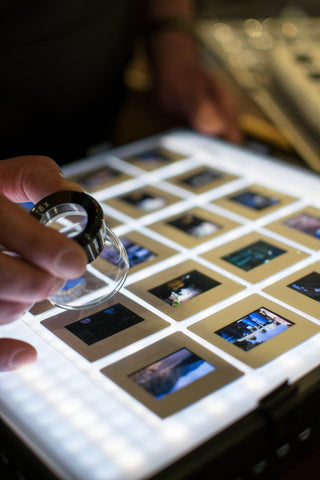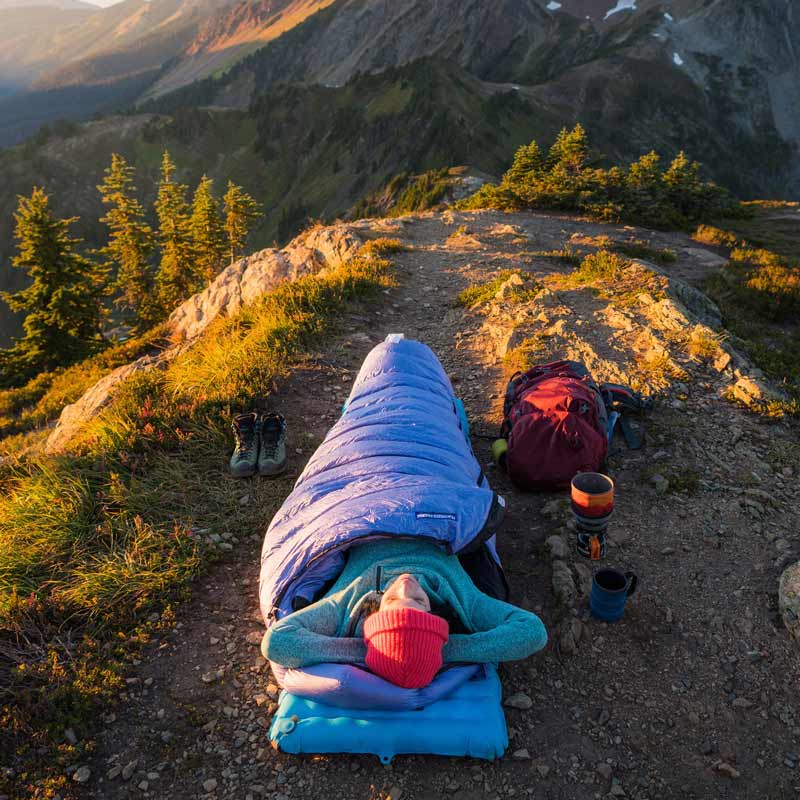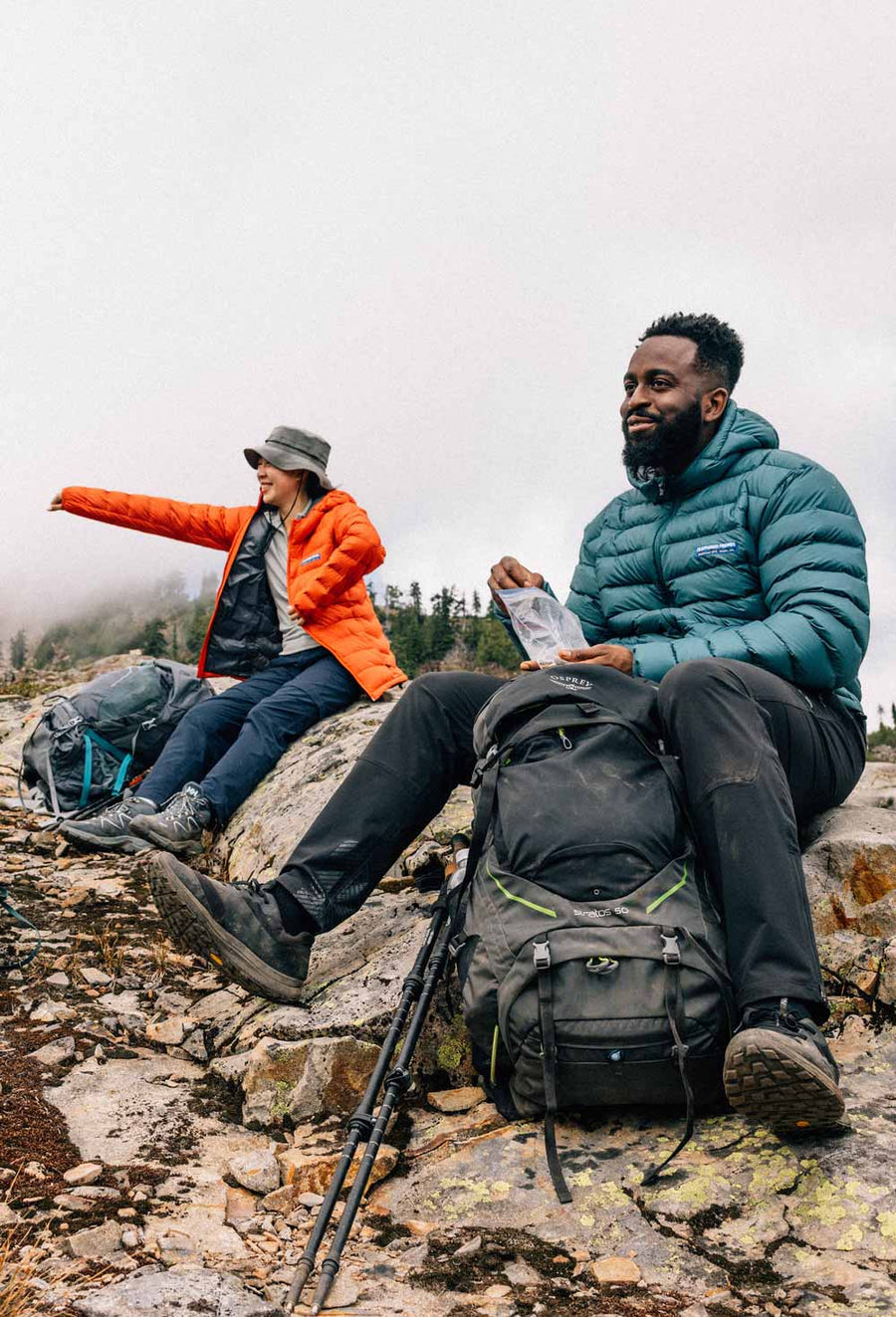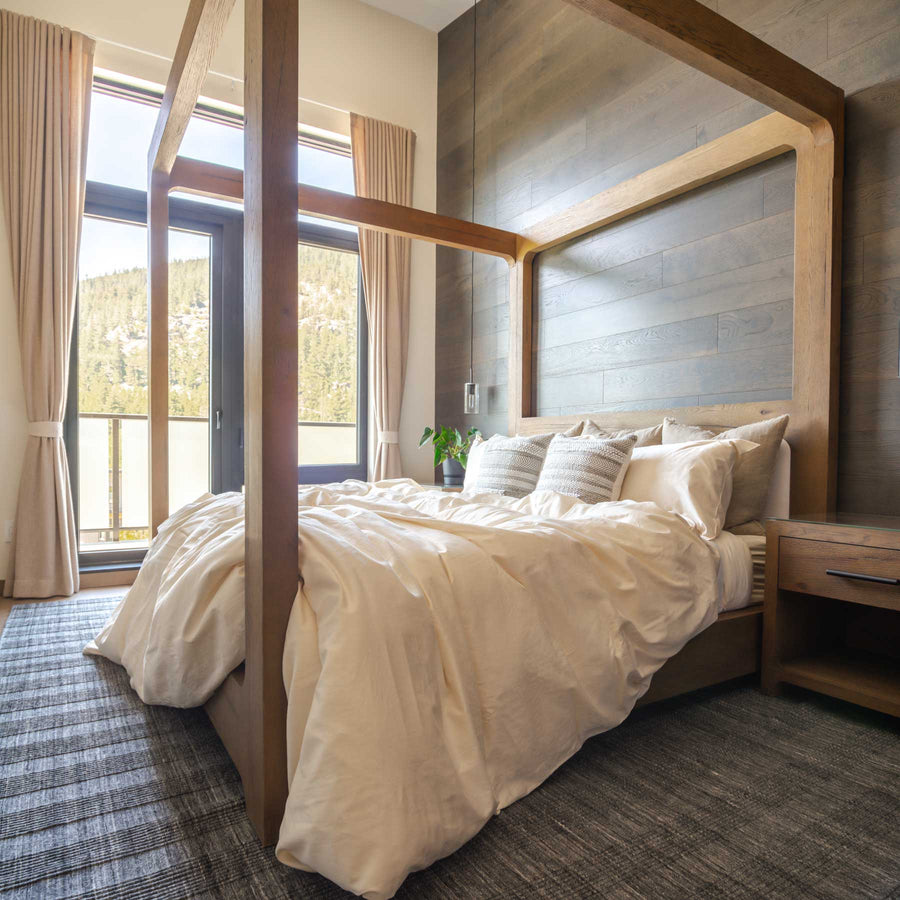Climbing at the Edge of Nowhere

This post is one of a series highlighting the outdoors experience of Feathered Friends employees. Written by Mandy Godwin.
The first I learn about his Aconcagua trip, Mike Burns is standing behind the desk at the Feathered Friends flagship Seattle store and holding a sheet of photo slides up to the light. He passes me the loupe, and holding the lens to the page, I see with incredible lucidity an image of him twenty years younger, wearing bright primary colors at high altitude in South America.
Those who meet Mike in the store could be forgiven for not immediately guessing his mountaineering background. Despite his extensive climbing resume, Mike isn’t the type to hold forth on the gravity of his accomplishments, and is much more likely to be found mid-deadpan, his quick grin hinting at a tendency to treat life as one long-running private joke just waiting to be shared.

Born in 1970 to a family of climbers, Mike has been scaling mountains since before he could walk. His parents became involved in climbing upon moving to the Pacific Northwest, and carried him up his first summits.
“By the time I was 9 or 10, I’d summited most of the smaller peaks around Mt. Rainier,” he says. Those nontechnical scrambles got him interested in tackling Rainier itself, which he climbed for the first time at age 18. It wasn’t long before he established himself within the local scene, beginning what he calls “the normal progression” for Seattle-based climbers by joining the northwest’s largest climbing community, the Mountaineers. He took their Basic Alpine Climbing Class, moved on to the Intermediate course, then began teaching and participating on committees while continuing to hone his skills.
By the mid-nineties, Mike had formed several close friendships with other climbers, and together with this group began to sketch out larger objectives. They set their sights on what would be Mike’s first set of international summits—the Mexican Volcanoes, a trio of peaks all higher than Rainier—and blessed with excellent weather, were able to summit all three in December 1994. This trip, something of a throwback to a similar expedition Mike’s father Bob Burns had taken in the 1970s, also served as a shakedown for the next attempt the group had in mind: Denali.
The next summer, they flew to Alaska to take on the tallest mountain in North America, the 20,310-foot centerpiece of the remote Alaska Range. On the way to basecamp, the Cessna pilot let Mike take over the controls. They would land at the Kahiltna Glacier, southwest of the peak itself, before making their way up the most commonly used route, the West Buttress. Denali, whose name means “the Great One” in the language of the native Koyukon people, is successfully climbed by only 40-60% of the teams who attempt it, depending on the season, and although they couldn’t yet know it, the luck Mike’s team had had with weather the previous year wasn’t destined to continue. An average Denali attempt takes 15-21 days, factoring in time needed to acclimatize and to wait out potentially adverse conditions, but some storms on the mountain can endure for days, if not weeks, derailing summit plans. Mike’s party reached Camp 4, the second-to-last before the summit, just as an unremitting storm rolled in and trapped them for more than a week.
“It was a disaster,” Mike laughs. “We were playing poker in igloos to pass the time.” Their sleeping bags froze, and they invented games to stave off the boredom. Steve Cox, one of Mike’s core team of climbers, remembers it well: “We were stormed in for ten days at the 14,000’ camp, and Mike recited an entire Stars Wars movie from memory. It was like watching it.” When reminded of this incident, Mike grins: “We did that in South America, too. Annoyed the shit out of everyone else at camp.”
That year, the weather forced their party off the mountain and sent them home to Seattle without a successful summit. Work unfinished, they returned in 1995 with a slightly different team, and this time, the weather held—mostly. On summit day, just above High Camp, the wind picked up.
“It was June, but the winds were howling through Denali Pass,” Mike recalls. Someone dropped a water bottle and it blew away, carried horizontally into the white abyss of the mountain. Some teams began to turn back, but Mike theorized that the winds were worst at the pass and might die down if only they climbed higher. Up they went. “I remember trying to peer out of the gap in the top of my iced-over sunglasses to see where we were going,” he says. They made the summit that day, and in the photo they took from the top, behind puffy jackets and glacier glasses, their cheeks are pink with windburn.

Back at home, Mike continued leading trips with the Mountaineers, as did Steve Cox, who would eventually become chairman of the climbing committee and serve on the Mountaineers’ board of directors. The year after Denali, both were selected to join a Mountaineers-organized team on an expedition in the Indian Himalaya. It was the first time American and Indian climbers were climbing together, and the region they chose, in the Himachal Pradesh, had only been explored by four other groups, none American.
After a multi-day approach, the team arrived at base camp in a basin ringed by a cirque of peaks. Only three had been summited, and Mike and Steve stayed up late discussing which to attempt.
“I asked our Sirdar [head sherpa], who had been there, ‘Did anybody climb this when you were here last?’ Nope. Well, okay, that’s going to be it,” Mike says. He and Steve set off early the next morning in the direction of the last contour lines on the map. The likelihood of avalanche danger was high, and at the day’s end, having nearly completed the approach, the two dug a flat area to sleep just downslope from a large crevasse, and could only hope that any loose snow from the pitches above would slide into the crevasse instead of crushing them.
“Of course we didn’t get any sleep that night,” Mike laughs. “We were truly in the middle of nowhere.” The Indian government forbade them access to the next map, which would show any features beyond the ones they could see, and the map they did have made no mention of the summit they were attempting: no name, no crossmark, no triangle indicating a peak. No pictures existed of the mountain’s opposite side.
“The next morning we woke up and were still alive. Sweet.” A giddy kind of relief enters Mike’s voice. Greeted with a bluebird morning, they packed up and made their way to the base of the climb. Steve asked Mike what they were going to do about the cornice near the summit, and Mike told him that they would figure it out when they got there.
Cornices, overhanging snow features created by wind on summits and ridges, create the impression of a cresting wave frozen at the top of a peak. At best, they present a challenging feature for climbers to scale. At worst, given to collapsing under pressure, they can be deadly.
Roped together with Mike in the lead, Mike and Steve reached the cornice. It was solid, unflinching in the face of Mike’s attempts to hack it away with his ice axe. Drawing on advice he’d read, Mike plunged his axe horizontally into the cornice itself, then worked his way up to use the head of the axe as a mantle, resting all his weight on it like a narrow shelf. With the protection that would stop his fall located far below, Mike reached up and worked his second axe into the cornice high above his head, praying that the first would hold. “I have to get this,” he thought, “because if I don’t, if this thing blows, it’s going to be bad.”
He got the move. The second axe in, he slid the horizontal one out, made one last placement, and pulled himself up over the lip of the cornice on his belly. He was four feet from the summit. From below, Steve called out, “Mike! How did you do that?”
Mike put Steve on belay and shouted down advice. “I remember having all this tension on him,” Mike says. “You can’t pull him up like in a movie. But I was doing anything I could do, because there was no way I could go back down that way.” Finally, his axe came over the edge, and Steve clambered up, panting. Together, they took the last few steps to the summit, where Mike unfurled a miniature American flag that he’d looped to his ice axe. “It was so rad,” he says, smile wide.

A challenge unique to mountaineering is that its emotional zenith, with the feeling of success and exhilaration that comes with reaching the summit, occurs in what is essentially the middle of every expedition. As evidenced by the January 2018 death of a climber on the descent from Nanga Parvat, the world’s 9th-highest peak, the way back down a mountain can be just as treacherous as the way up. Mike and Steve still had to get back to camp, and had to do so without maps or any information about their route.
They walked to the opposite side and peered over the edge, braced for the sight of a sheer drop. “Oh my god, are we going to cliff out?” Mike wondered. But no; there below them, a slope opened up—a possible way down. Steve lowered Mike, and here, again, trusting the odds and faced with no other way back, they braced themselves against the unknown until they could once again see below the edge, and met with another slope, could exhale. Finally, after six or seven lowers, they reached a glacier that led back to camp.
“The truth is,” Steve says, reflecting, “we don’t get to face the unknown much anymore. We did on that trip.”
It’s this, what he calls “an intense feeling of exploration,” that Mike most vividly recalls about completing a first ascent. He spends little time considering how impressive the feat may appear to others—he shrugs and says that it’s nothing like being the first American woman to summit K2, which happened only last year—in part because, within the context he found himself, continuing on to guide internationally and be surrounded by climbers at the highest level, his first ascent was comparatively minor. But beyond that, it’s that recognition, glory, and even achievement aren’t primary drivers for Mike’s climbs. “For years, I was doing it because I was expected to,” he admits: his parents had climbed, he was talented and had begun to teach and guide. “What else would I do?”
But what he comes back to, in all his stories, is the time spent with other people on the mountain: the image of himself and Steve falling asleep half-outside their tent watching a meteor shower in the Himalaya, teaching their porters bouldering techniques, or convincing the pizza delivery guy to bring a case of beer to their hotel room the night after they climbed Mt. Shasta. Ultimately, when asked why he climbs, Mike affirms, “It’s the camaraderie. Once you get a group of people you enjoy doing things with, you can go experience a mountain environment with that group and have a great time.”

So is K2 or Everest in the cards? “Not a chance in hell,” he says, shaking his head. Always more interested in a different kind of mountaineering—just two guys climbing at the edge of nowhere and trying together to figure out their next move—Mike shifted his focus to education after the gradual changing of priorities among his core group of climbing friends. With his father, Bob Burns, he co-authored Wilderness Navigation, widely regarded as the authoritative book on staying found, and has also contributed to the “mountaineering Bible,” Mountaineering: Freedom of the Hills.
“I like to say that I’m a semi-retired mountaineering guide,” he says. He and his dad still climb together periodically, and he hasn’t sold any of his gear. “There’s that great scene in the newest Indiana Jones movie,” he reminds me, where the younger protagonist looks up at the imposing figure of Harrison Ford and asks, incredulous, “You’re a teacher?” Indiana, with his wry humor, answers: “Part-time.” Mike nods in solidarity and repeats, as to himself, “Semi-retired.”








Leave a comment